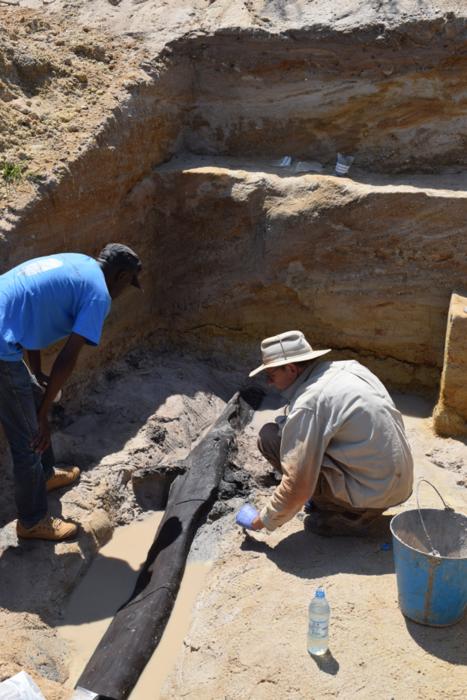Archaeologists discover world’s oldest wooden structure at Kalambo Falls
Half a million years ago, earlier than was previously thought possible, humans were building structures made of wood, according to new research by a team from the University of Liverpool and Aberystwyth University.
The research, published in the journal Nature, reports on the excavation of well-preserved wood at the archaeological site of Kalambo Falls, Zambia, dating back at least 476,000 years and predating the evolution of our own species, Homo sapiens.
Expert analysis of stone tool cut-marks on the wood show that these early humans shaped and joined two large logs to make a structure, probably the foundation of a platform or part of a dwelling.
This is the earliest evidence from anywhere in the world of the deliberate crafting of logs to fit together. Until now, evidence for the human use of wood was limited to its use for making fire, digging sticks and spears.
Wood is rarely found in such ancient sites as it usually rots and disappears, but at Kalambo Falls permanently high water levels preserved the wood.
This discovery challenges the prevailing view that Stone Age humans were nomadic. At Kalambo Falls these humans not only had a perennial source of water, but the forest around them provided enough food to enable them to settle and make structures.
Professor Larry Barham, from the University of Liverpool’s Department of Archaeology, Classics and Egyptology, who leads the ‘Deep Roots of Humanity’ research project said:
“This find has changed how I think about our early ancestors. Forget the label ‘Stone Age,’ look at what these people were doing: they made something new, and large, from wood. They used their intelligence, imagination, and skills to create something they’d never seen before, something that had never previously existed.”
“They transformed their surroundings to make life easier, even if it was only by making a platform to sit on by the river to do their daily chores. These folks were more like us than we thought.”
The specialist dating of the finds was undertaken by experts at Aberystwyth University.
They used new luminescence dating techniques, which reveal the last time minerals in the sand surrounding the finds were exposed to sunlight, to determine their age.
Professor Geoff Duller from Aberystwyth University said:
“At this great age, putting a date on finds is very challenging and we used luminescence dating to do this. These new dating methods have far reaching implications – allowing us to date much further back in time, to piece together sites that give us a glimpse into human evolution. The site at Kalambo Falls had been excavated back in the 1960s when similar pieces of wood were recovered, but they were unable to date them, so the true significance of the site was unclear until now.”
The site of Kalambo Falls on the Kalambo River lies above a 235 metres (772 foot) waterfall on the border of Zambia with the Rukwa Region of Tanzania at the edge of Lake Tanganyika. The area is on a ‘tentative‘ list from UNESCO for becoming a World Heritage site because of its archaeological significance.
Professor Duller added:
“Our research proves that this site is much older than previously thought, so its archaeological significance is now even greater. It adds more weight to the argument that it should be a United Nations World Heritage Site.”
This research forms part of the pioneering ‘Deep Roots of Humanity’ project, an investigation into how human technology developed in the Stone Age. The project is funded by the UK’s Arts and Humanities Research Council and involved teams from Zambia’s National Heritage Conservation Commission, Livingstone Museum, Moto Moto Museum and the National Museum, Lusaka.
Professor Barham added:
“Kalambo Falls is an extraordinary site and a major heritage asset for Zambia. The Deep Roots team is looking forward to more exciting discoveries emerging from its waterlogged sands.”
Bibliographic information:
Evidence for the earliest structural use of wood at least 476,000 years ago, Nature (20-Sep-2023), DOI: 10.1038/s41586-023-06557-9
Press release from the University of Liverpool.









2 Comments
Raft?
Thank you for the question! The authors explained that “Expert analysis of stone tool cut-marks on the wood show that these early humans shaped and joined two large logs to make a structure, probably the foundation of a platform or part of a dwelling.”
In the study, published on Nature (it’s open source, so it can be freely accessed if you wish to check further) they add more about the “two interlocking logs joined transversely by an intentionally cut notch”:
“The interlocking logs from BLB5 anticipate hafting’s core concept: the combination of two or more parts to make a construction, enhancing our understanding of the technical cognition of these toolmakers.”
And also: “Life in a periodically wet floodplain would be enhanced by constructing a raised platform, walkway or foundation for dwellings.”